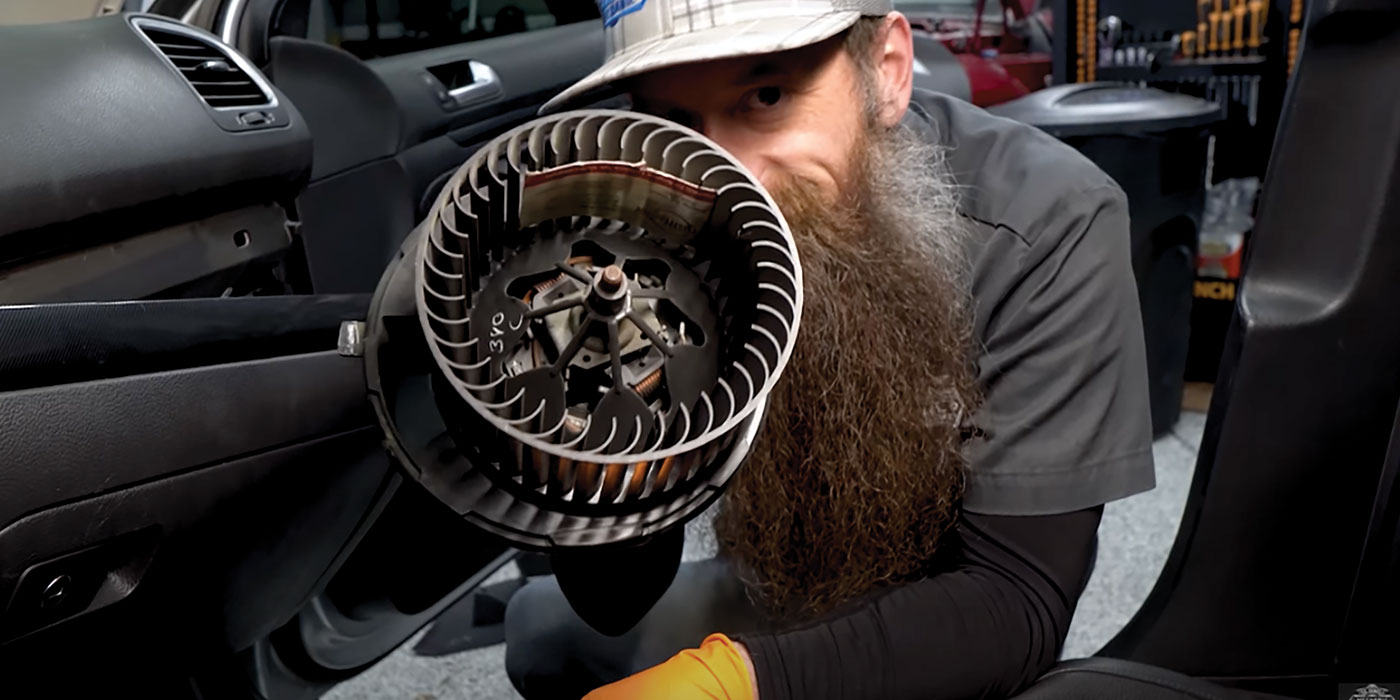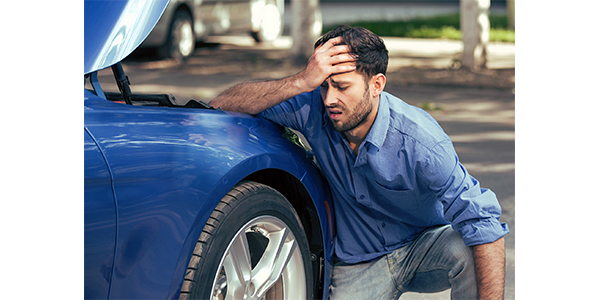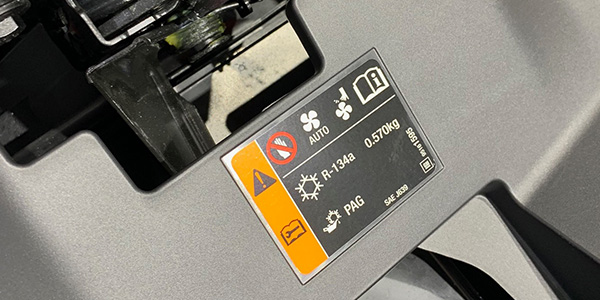It sounds like a bad barroom bet: Buy a $250 car and drive it from New York to New Orleans and back. This is what a recent cross-country rally did when it challenged 28 competitors to take on the roads in a junker, jalopy or beater for the top prize of $1,500.
The inaugural running of the Big Apple to the Big Easy (BABE) Rally (www.baberally.com) took place over the 2006 Memorial Day weekend. It was a form of automotive insanity that stresses creativity and automotive knowledge, not the size of your wallet.
Our team was comprised of myself; Brendan Baker, the managing editor of our sister publication Engine Builder; and Gene Markel, a contributing editor for BRAKE & FRONT END.
Looking for the car was like playing Fantasy Football. While searching for the car, the team members debated the fatal flaws, like timing belts, head gaskets and other major maladies, that could put us on the hook of a tow truck with an impossible road repair.
The car we found was a “barn fresh” 1967 AMC Rambler American. It was owned by a “little old lady” and was driven sporadically the past 30 years. We knew we had a good car when people would say, “You’re going where? In that?!”
Our team decided to do minimal prep before we left for New York. The rear leaf springs were sagging from extra weight put in the trunk for winter traction. We decided to make due with helper springs. But, it was in the back of our minds that we could hit a bump and the rear may not come back up or the universal joints could fail.
We acquired a new set of tires through our sponsor RIM & TRIM of Kent, OH. We mounted them at the Hunter Engineering Regional Training Center in Stow, OH, with the help of Frank Ponte. On the alignment rack, Frank saw the results of the bad leaf springs in a .25º thrust angle that helped to explain the mis-aligned steering wheel.
The car did not have the greatest brakes when I first drove it home, so I assumed that this is how all four-wheel drum cars performed for this era. I pulled the drums and saw that the shoes looked OK and the wheel cylinders did not look like they were leaking. The self-adjusters were missing, but the springs were rigged up in a way that looked OK.
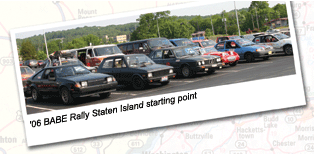 Ramblin’ Journey Begins
Ramblin’ Journey Begins
Along the 500-mile journey from Akron to the BABE Rally start in New York, we had a chance to see what the car could do on the freeway. When we had emptied the first tank of gas, we took the next exit to fill up the tank.
With the first press of the brake pedal, it almost hit the floor! On the second hit, the pedal was now hard and the car suddenly pulled to the left. On the third pump, the car slowed in a predictable manner.
The rigged-up, over-extended springs would knock back on the pistons in the wheel cylinders as we drove on the freeway. This would displace fluid from the cylinders and cause the initial low pedal. We decided that it would be easier to adjust our driving style rather than messing with the brakes that night.
Driving through Clarion, PA, we started to drag our muffler. We cut the muffler off and continued, but the back seat was now a torture chamber of noise and fumes. It was almost 5 a.m. by the time we arrived on Staten Island, NY. The three hours of sleep in a $200 hotel room seemed like a bargain.
Day 1: New York to Virginia
The race started at 9 a.m. at the Staten Island Mall parking lot. In a small corner, the 28 cars, worth an estimated total of $7,000 ($250 each), were being prepped for the beginning of the rally. The security guard was keeping his distance, fearing that a demolition derby might break out at any minute.
The race started with a few words from the organizers and a blast from an air horn to signal the competitors to pick up the challenge packets. On that day, teams had to take pictures of certain colored cars in a sequence with a digital camera. This created a problem for Team Triangle and their three-wheeled Honda CRX.
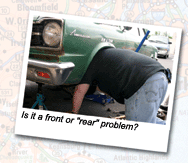 While taking a picture of a brown SUV, the driver thought that he was being harassed by the CRX. The driver of the SUV followed them to the first traveler’s plaza on the New Jersey Turnpike, blocked them in and called 911.
While taking a picture of a brown SUV, the driver thought that he was being harassed by the CRX. The driver of the SUV followed them to the first traveler’s plaza on the New Jersey Turnpike, blocked them in and called 911.
The New Jersey State Police officer straightened out the photo problem and moved on to the issue that the car only had three wheels. After endless discussions about the New Jersey motor vehicles laws, the only ticket that could be issued was for a broken windshield.
The stop-and-go traffic of Philadelphia, Washington DC and Baltimore was not much fun. Approaching some tollbooths, it was a struggle to keep the car in the same lane during the first brake application. When we rolled into Harrisonburg, VA, we resolved that we would do something about the brakes, but in the morning.
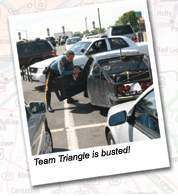 Day 2: Virginia to Tennessee
Day 2: Virginia to Tennessee
When we pulled the front drums, Gene realized that whoever had put on the left side shoes had them reversed. This helped to explain why the “short shoe” was worn to the metal at the top and the long shoe was overheating and de-bonding. After we made multiple calls to local parts stores, we decided to adjust the brakes and “engine brake” whenever possible.
In Harrisonburg, we managed to find an Advance Auto Parts store. The counter people were more than helpful and even let us work in the lot and wash up in back. We decided to take the opportunity to patch together an exhaust system from flex pipe and a glasspak muffler.
We replaced the spark plugs as a way to save on gas money. The number-one spark plug had a huge deposit of ash on the electrode and the gap was worn to 0.052”. We convinced ourselves that it was just neglect and not a bad head gasket.
With the new spark plugs and muffler, we hit the road again. The car now was running great, with the extra backpressure the car had better throttle response and you could actually sleep in the back seat.
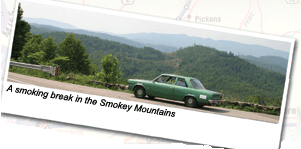 Day 3: Smokey Mountains to Alabama
Day 3: Smokey Mountains to Alabama
Our route for that day was through the Smokey Mountain National Park and along Route 29 that goes through Tennessee, North Carolina and Alabama. The road was a departure from the freeways and was mostly curvy two-lane blacktop.
The highlight of the day was US-129 and Deals Gap, or as the locals call it, “The Tail of the Dragon.” The 11-mile road has more than 300 bends. When we rolled into the hotel in Fort Payne, AL, we were happy we still had brakes.
Day 4: Alabama to New Orleans
The final day of the rally was a 400-plus mile drive. The route we took was mostly on freeways through Alabama, Mississippi and Louisiana. Due to the hot weather, our cruising speed was limited to 65 mph. Any speed over that for an extended distance would cause the temp gauge to creep up to dangerous levels.
The closer we came to New Orleans, the damage of Katrina became more evident. Driving down I-10 and the bridge over Lake Constrain, there are still temporary spans keeping the bridge open. In the city, you can still see that New Orleans has a long way to go before it is restored to its former glory. The awards party was at Pat O’Brien’s on Bourbon Street. It was a chance to share travel “war” stories, congratulate the winners and plan for next year.
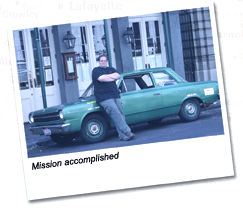 Day 5: The long trip home
Day 5: The long trip home
It is almost exactly 1,000 miles from New Orleans to Akron, OH. We decided to make the 15-hour drive in one day barring any unforeseen problems. About halfway through, it was apparent that the car would wear us out before we wore it out. Once we hit the cooler air of the North, we were able to cruise at a comfortable 75 mph.
Between gas and hotels, we managed to rack up a grand total of $950 on our credit cards. But, divided three ways it was a real bargain. We all had a great sense of accomplishment, became friends with a great bunch of people and saw a part of the country in a whole new way. Will I do it next year? There’s no doubt. Now only if I could find a $250 school bus to get the per person expense lower.





